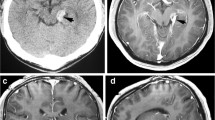Abstract
Background
Internal maxillary artery (IMA) bypass has become popularized due to its medium-to-high blood flow, short graft length, and well-matched arterial caliber between donor and recipient vessels.
Method
We described an open surgery of a NEW “workhorse,” the IMA bypass, to treat a giant, thrombosed cerebral aneurysm. The extracranial middle infratemporal fossa (EMITF) approach was used to unveil the pterygoid segment of the IMA for cerebral revascularization.
Conclusion
Although this technique is technically challenging, the variations in IMA can be effectively identified and sufficiently exposed in this technique to achieve favorable clinical outcomes with a high bypass patency rate.






Similar content being viewed by others
Abbreviations
- ECA:
-
External carotid artery
- MCA:
-
Middle cerebral artery
- ICA:
-
Internal carotid artery
- ICG:
-
Indocyanine green
- IMA:
-
Internal maxillary artery
- LPM:
-
Lateral pterygoid muscle
- MPM:
-
Medial pterygoid muscle
- RA:
-
Radial artery
- TM:
-
Temporalis muscle
- I2 :
-
Pterygoid segment of internal maxillary artery
- M2:
-
Sphenoidal segment of middle cerebral artery
References
Nossek E, Costantino PD, Chalif DJ, Ortiz RA, Dehdashti AR, Langer DJ (2016) Forearm cephalic vein graft for short, “middle”-flow, internal maxillary artery to middle cerebral artery bypass. Oper Neurosurg 12(2):99–105
Nossek E, Costantino PD, Eisenberg M, Dehdashti AR, Setton A, Chalif DJ, Ortiz RA, Langer DJ (2014)
Nossek Erez, Costantino Peter D, Eisenberg Mark, Dehdashti Amir R, Setton Avi, Chalif David J, Ortiz Rafael A, Langer David J (2014) Internal Maxillary Artery-Middle Cerebral Artery Bypass: Infratemporal Approach for Subcranial-Intracranial (SC-IC) Bypass. Neurosurgery 75(1):87–95
Nossek E, Langer DJ (2018) Internal maxillary artery to middle cerebral artery cranial bypass: the new “work horse” for cerebral flow replacement. World Neurosurg 115:44–46
Patel NV, Ligas B, Gandhi S, Ellis J, Ortiz R, Costantino P, Qato K, Langer DJ (2020) Internal maxillary to middle cerebral artery bypass using an anterior tibial artery graft, performed using a 3-dimensional exoscope: 2-dimensional operative video. Oper Neurosurg 19(2):E187
Wang L, Cai L, Lu S, Qian H, Lawton MT, Shi X (2018) The history and evolution of internal maxillary artery bypass. World Neurosurg 113:320–332
Wang L, Lu S, Cai L, Qian H, Tanikawa R, Shi X (2019) Internal maxillary artery bypass for the treatment of complex middle cerebral artery aneurysms. Neurosurg Focus 46:E10
Wang L, Lu S, Qian H, Shi X (2017) Internal maxillary artery bypass with radial artery graft treatment of giant intracranial aneurysms. World Neurosurg 105:568–584
Wang L, Lu S, Qian H, Shi X (2017) Internal maxillary bypass for complex pediatric aneurysms. World Neurosurg 103:395–403
Wang L, Shi X, Liu F, Qian H (2016) Bypass surgery to treat symptomatic fusiform dilation of the internal carotid artery following craniopharyngioma resection: report of 2 cases. Online publication of Neurosurg Focus 41:E17
Wang L, Shi X, Qian H (2017) Flow reversal bypass surgery: a treatment option for giant serpentine and dolichoectatic aneurysms-internal maxillary artery bypass with an interposed radial artery graft followed by parent artery occlusion. Neurosurg Rev 40:319–328
Funding
The Application and Evaluation of Active Health Cloud Platform in China, National Key R&D Program of China (2018YFC2000704).
Author information
Authors and Affiliations
Contributions
Conception and design: Wang. Acquisition of data: Wang, Liu, Shi. Drafting the article: Wang, Jing. Critically revising the article: Wang. Reviewed submitted version of manuscript: all authors. Study supervision: Wang, Shi.
Corresponding author
Ethics declarations
Ethical approval
Not applicable.
Conflict of interest
The authors declare no competing interests.
Additional information
Publisher's note
Springer Nature remains neutral with regard to jurisdictional claims in published maps and institutional affiliations.
Key points
1. The anatomy of the donor artery is the key to accomplishing IMA bypass.
2. A preoperative angiography study was performed to confirm the anatomical course and pattern of the IMA.
3. An RA graft of adequate length should be harvested to avoid tensive anastomosis status.
4. Zygomatic resection was mandatory for fully unveiling the neurovasculatures within the deeply located infratemporal fossa.
5. The 2nd segment of the IMA is the best candidate for well-matched anastomosis with RA grafts.
6. The Sylvian fissures should be adequately exposed as much as possible to reveal the distal structure and outflow of aneurysms.
7. Cut flow was measured before and after intracranial vascular anastomosis, and a higher ratio indicated a better patency rate.
8. Continuous irrigation with saline solution was used to make the surgical field clear and keep the tissues moist.
9. Adjunctive tools, such as neuro-monitoring, ICG imaging, and ultrasonic probes, were used to keep the bypass safe.
10. Blood pressure control, heparin therapy, and hydration had positive effects on the prevention of intracranial complications.
This article is part of the Topical Collection on Vascular Neurosurgery—Aneurysm
Supplementary Information
Below is the link to the electronic supplementary material.
Supplementary file1 (MP4 90327 KB)
Rights and permissions
Springer Nature or its licensor (e.g. a society or other partner) holds exclusive rights to this article under a publishing agreement with the author(s) or other rightsholder(s); author self-archiving of the accepted manuscript version of this article is solely governed by the terms of such publishing agreement and applicable law.
About this article
Cite this article
Wang, L., Jing, L., Liu, F. et al. How I do it: internal maxillary artery to middle cerebral artery bypass to manage giant thrombosed internal carotid artery aneurysm. Acta Neurochir 165, 495–499 (2023). https://doi.org/10.1007/s00701-022-05463-9
Received:
Accepted:
Published:
Issue Date:
DOI: https://doi.org/10.1007/s00701-022-05463-9




